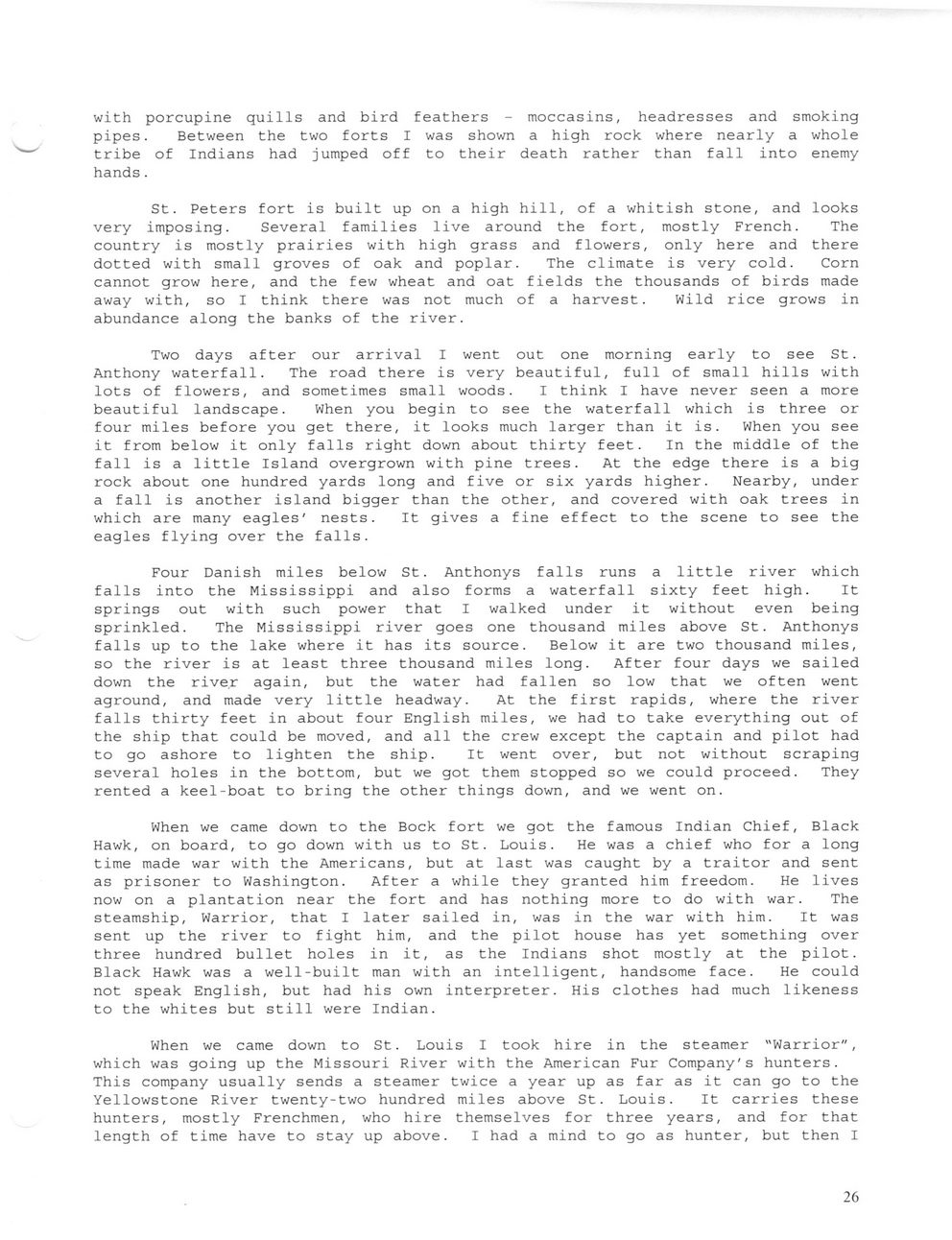This text was obtained via automated optical character recognition.
It has not been edited and may therefore contain several errors.
with porcupine quills and bird feathers - moccasins, headresses and smoking pipes. Between the two forts I was shown a high rock where nearly a whole tribe of Indians had jumped off to their death rather than fall into enemy hands. St. Peters fort is built up on a high hill, of a whitish stone, and looks very imposing. Several families live around the fort, mostly French. The country is mostly prairies with high grass and flowers, only here and there dotted with small groves of oak and poplar. The climate is very cold. Corn cannot grow here, and the few wheat and oat fields the thousands of birds made away with, so I think there was not much of a harvest. Wild rice grows in abundance along the banks of the river. Two days after our arrival I went out one morning early to see St. Anthony waterfall. The road there is very beautiful, full of small hills with lots of flowers, and sometimes small woods. I think I have never seen a more beautiful landscape. When you begin to see the waterfall which is three or four miles before you get there, it looks much larger than it is. When you see it from below it only falls right down about thirty feet. In the middle of the fall is a little Island overgrown with pine trees. At the edge there is a big rock about one hundred yards long and five or six yards higher. Nearby, under a fall is another island bigger than the other, and covered with oak trees in which are many eagles' nests. It gives a fine effect to the scene to see the eagles flying over the falls. Four Danish miles below St. Anthonys falls runs a little river which falls into the Mississippi and also forms a waterfall sixty feet high. It springs out with such power that I walked under it without even being sprinkled. The Mississippi river goes one thousand miles above St. Anthonys falls up to the lake where it has its source. Below it are two thousand miles, so the river is at least three thousand miles long. After four days we sailed down the river again, but the water had fallen so low that we often went aground, and made very little headway. At the first rapids, where the river falls thirty feet in about four English miles, we had to take everything out of the ship that could be moved, and all the crew except the captain and pilot had to go ashore to lighten the ship. It went over, but not without scraping several holes in the bottom, but we got them stopped so we could proceed. They rented a keel-boat to bring the other things down, and we went on. When we came down to the Bock fort we got the famous Indian Chief, Black Hawk, on board, to go down with us to St. Louis. He was a chief who for a long time made war with the Americans, but at last was caught by a traitor and sent as prisoner to Washington. After a while they granted him freedom. He lives now on a plantation near the fort and has nothing more to do with war. The steamship, Warrior, that I later sailed in, was in the war with him. It was sent up the river to fight him, and the pilot house has yet something over three hundred bullet holes in it, as the Indians shot mostly at the pilot. Black Hawk was a well-built man with an intelligent, handsome face. He could not speak English, but had his own interpreter. His clothes had much likeness to the whites but still were Indian. When we came down to St. Louis I took hire in the steamer "Warrior", which was going up the Missouri River with the American Fur Company's hunters. This company usually sends a steamer twice a year up as far as it can go to the Yellowstone River twenty-two hundred miles above St. Louis. It carries these hunters, mostly Frenchmen, who hire themselves for three years, and for that length of time have to stay up above. I had a mind to go as hunter, but then I 26

Koch, Christian Diary-26